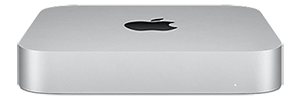|
Mini-DVI
The Mini-DVI connector is used on certain Apple computers as a digital alternative to the Mini-VGA connector. Its size is between the full-sized DVI and the tiny Micro-DVI. It is found on the 12-inch PowerBook G4 (except the original 12-inch 867 MHz PowerBook G4, which used Mini-VGA), the Intel-based iMac, the MacBook Intel-based laptop, the Intel-based Xserve, the 2009 Mac mini, and some late model eMacs. In October 2008, Apple announced the company was phasing Mini-DVI out in favor of Mini DisplayPort. Mini-DVI connectors on Apple hardware are capable of carrying DVI, VGA, or TV signals through the use of adapters, detected with EDID (Extended display identification data) via DDC. This connector is often used in place of a DVI connector in order to save physical space on devices. Mini-DVI does not support dual-link connections and hence cannot support resolutions higher than 1920×1200 @60 Hz. There are various types of Mini-DVI adapter: *Apple Mini-DVI to VGA ... [...More Info...] [...Related Items...] OR: [Wikipedia] [Google] [Baidu] |
Mini DisplayPort
The Mini DisplayPort (MiniDP or mDP) is a miniaturized and less common version of the DisplayPort audio-visual digital interface. It was announced by Apple in October 2008, and by early 2013 all new Apple Macintosh computers had Mini DisplayPort, as did the LED Cinema Display. However, in 2016 Apple began phasing out the port and replacing it with the new USB-C connector. The Mini DisplayPort is also fitted to some PC motherboards, video cards, and some PC notebooks from Asus, Microsoft, MSI, Lenovo, Toshiba, HP, Dell, and other manufacturers. Apple offers a free license for the Mini DisplayPort but they reserve the right to cancel the license should the licensee "commence an action for patent infringement against Apple". Specifications Unlike its Mini-DVI and Micro-DVI predecessors, the Mini DisplayPort can drive display devices with resolutions up to 2560×1600 (WQXGA) in its DisplayPort 1.1a implementation, and 4096×2160 ( 4K) in its DisplayPort 1.2 implementation. ... [...More Info...] [...Related Items...] OR: [Wikipedia] [Google] [Baidu] |
Mac Mini
Mac Mini (stylized as Mac mini) is a small form factor desktop computer developed and marketed by Apple Inc. , it is positioned between the consumer all-in-one iMac and the professional Mac Studio and Mac Pro as one of four current Mac desktop computers. Since launch, it has shipped without a display, keyboard, and mouse. The machine was initially branded as "BYODKM" (Bring Your Own Display, Keyboard, and Mouse) as a strategic pitch to encourage users to switch from PCs running operating systems such as Microsoft Windows and Linux. In January 2005, the original Mac Mini was introduced with the PowerPC G4 CPU. In February 2006, Apple announced the second-generation lineup. It featured more advanced components and internal software updates, and it switched the CPU to the Intel Core Solo. The third-generation, which was unveiled in June 2010, had a thinner, unibody aluminum case and an HDMI port, and was more readily positioned as a home theater device and an alternative to th ... [...More Info...] [...Related Items...] OR: [Wikipedia] [Google] [Baidu] |
Mini-VGA
Mini-VGA connectors are a non-standard, proprietary alternative used on some laptops and other systems in place of the standard VGA connector, although most laptops use a standard VGA connector. Apple, HP and Asus have separate implementations using the same name. Apart from its compact form, mini-VGA ports have the added ability to output both composite and S-Video in addition to VGA signals through the use of EDID. The mini-DVI and now Mini DisplayPort connectors have largely replaced mini-VGA. Mini-VGA connectors are most commonly seen on Apple's iBooks, eMacs, early PowerBooks (12 inch), and some iMacs (e.g. the iMac G5), but has also been included on several laptops manufactured by Sony. HP's versions are found in HP Minis and HP TouchSmarts. The mini-VGA connector can also be used for video output. In this mode, S-Video chrominance (C) and luminance (Y) signals replace the red and green channels, while an equivalent composite video Composite video is an ana ... [...More Info...] [...Related Items...] OR: [Wikipedia] [Google] [Baidu] |
Digital Visual Interface
Digital Visual Interface (DVI) is a video display interface developed by the Digital Display Working Group (DDWG). The digital interface is used to connect a video source, such as a video display controller, to a display device, such as a computer monitor. It was developed with the intention of creating an industry standard for the transfer of digital video content. This interface is designed to transmit uncompressed digital video and can be configured to support multiple modes such as DVI-A (analog only), DVI-D (digital only) or DVI-I (digital and analog). Featuring support for analog connections, the DVI specification is compatible with the VGA interface. This compatibility, along with other advantages, led to its widespread acceptance over competing digital display standards Plug and Display (P&D) and Digital Flat Panel (DFP). Although DVI is predominantly associated with computers, it is sometimes used in other consumer electronics such as television sets and DVD p ... [...More Info...] [...Related Items...] OR: [Wikipedia] [Google] [Baidu] |
Micro-DVI
The Micro-DVI port is a proprietary video output port found in the original MacBook Air. It is smaller than the Mini-DVI port used by its MacBook models. To use the port for displaying video on a standard monitor or television, an adapter must be used. Both a Micro-DVI to DVI adapter and a Micro-DVI to VGA adapter were bundled with the original MacBook Air. A Micro-DVI to Video adapter, which provided composite and S-video outputs, was also sold separately. The Micro-DVI to DVI adapter is only compatible with a DVI-D (digital) signal; DVI-A and DVI-I signals do not work as they do not have the required analog connections. The Micro-DVI connector was replaced with the Mini DisplayPort connector starting with the Late 2008 MacBook Air, making it one of the shortest lived connectors created by Apple. Additionally, the Asus U2E subnotebook includes a "Micro-DVI" port, which unlike the Apple version has the same form factor as HDMI. Although it is electrically compatible with HDMI, ... [...More Info...] [...Related Items...] OR: [Wikipedia] [Google] [Baidu] |
PowerBook G4
The PowerBook G4 is a series of notebook computers manufactured, marketed, and sold by Apple Computer between 2001 and 2006 as part of its PowerBook line of notebooks. The PowerBook G4 runs on the RISC-based PowerPC G4 processor, designed by the AIM (Apple/ IBM/Motorola) development alliance and initially produced by Motorola. It was built later by Freescale, after Motorola spun off its semiconductor business under that name in 2004. The PowerBook G4 has two different designs: one enclosed in a titanium body with a translucent black keyboard and a 15-inch screen; and another in an aluminum body with an aluminum-colored keyboard, in 12-inch, 15-inch, and 17-inch sizes. Between 2001 and 2003, Apple produced the titanium PowerBook G4; between 2003 and 2006, the aluminum models were produced. Both models were hailed for their modern design, long battery life, and processing power. When the aluminum PowerBook G4s were first released in January 2003, 12-inch and 17-inch models were i ... [...More Info...] [...Related Items...] OR: [Wikipedia] [Google] [Baidu] |
Xserve
Xserve is a line of rack unit computers designed by Apple Inc. for use as servers. Introduced in 2002, it was Apple's first designated server hardware design since the Apple Network Server in 1996. In the meantime, ordinary Power Macintosh G3 and G4 models were rebranded as Macintosh Server G3 and Macintosh Server G4 with some alterations to the hardware, such as added Gigabit Ethernet cards, UltraWide SCSI cards, extra large and fast hard drives etc. and shipped with Mac OS X Server software. The Xserve initially featured one or two processors, but later switched over to the then-new transitioned to Intel with the Core 2-based Xeon offerings and subsequently switched again to two quad-core microprocessors. The Xserve could be used for a variety of applications, including file server, web server or even high-performance computing applications using clustering – a dedicated cluster Xserve, the Xserve Cluster Node, without a video card and optical drives was also availabl ... [...More Info...] [...Related Items...] OR: [Wikipedia] [Google] [Baidu] |
Display Data Channel
The Display Data Channel, or DDC, is a collection of protocols for digital communication between a computer display and a graphics adapter that enable the display to communicate its supported display modes to the adapter and that enable the computer host to adjust monitor parameters, such as brightness and contrast. Like modern analog VGA connectors, the DVI and DisplayPort connectors include pins for DDC, but DisplayPort only supports DDC within its optional Dual-Mode DP ( DP++) feature in DVI/HDMI mode. The standard was created by the Video Electronics Standards Association (VESA). Overview The DDC suite of standards aims to provide Plug and Play and DPMS power management experiences for computer displays. DDC1 and DDC2B/Ab/B+/Bi protocols are a physical link between a monitor and a video card, which was originally carried on either two or three pins in a 15-pin analog VGA connector. Extended display identification data (EDID) is a companion standard; it defines a compact ... [...More Info...] [...Related Items...] OR: [Wikipedia] [Google] [Baidu] |
Digital Display Connectors
Digital usually refers to something using discrete digits, often binary digits. Technology and computing Hardware *Digital electronics, electronic circuits which operate using digital signals **Digital camera, which captures and stores digital images ***Digital versus film photography **Digital computer, a computer that handles information represented by discrete values **Digital recording, information recorded using a digital signal Socioeconomic phenomena *Digital culture, the anthropological dimension of the digital social changes *Digital divide, a form of economic and social inequality in access to or use of information and communication technologies *Digital economy, an economy based on computing and telecommunications resources Other uses in technology and computing *Digital data, discrete data, usually represented using binary numbers *Digital marketing, search engine & social media presence booster, usually represented using online visibility. * Digital media, media st ... [...More Info...] [...Related Items...] OR: [Wikipedia] [Google] [Baidu] |
Composite Video
Composite video is an analog video signal format that carries standard-definition video (typically at 525 lines or 625 lines) as a single channel. Video information is encoded on one channel, unlike the higher-quality S-Video (two channels) and the even higher-quality component video (three or more channels). In all of these video formats, audio is carried on a separate connection. Composite video is also known by the initials CVBS for composite video baseband signal or color, video, blanking and sync, or is simply referred to as ''SD video'' for the standard-definition television signal it conveys. There are three dominant variants of composite video signals, corresponding to the analog color system used: NTSC, PAL, and SECAM. Usually composite video is carried by a yellow RCA connector, but other connections are used in professional settings. Signal components A composite video signal combines, on one wire, the video information required to recreate a color pic ... [...More Info...] [...Related Items...] OR: [Wikipedia] [Google] [Baidu] |
S-Video
S-Video (also known as separate video, Y/C, and erroneously Super-Video ) is an analog video signal format that carries standard-definition video, typically at 525 lines or 625 lines. It encodes video luma and chrominance on two separate channels, achieving higher image quality than composite video which encodes all video information on one channel. It also eliminates several types of visual defects such as dot crawl which commonly occur with composite video. Although it improved over composite video, S-Video has lower color resolution than component video, which is encoded over three channels. The Atari 800 was the first to introduce separate Chroma/Luma output in late 1979. However, S-Video did not get widely adopted until JVC's introduction of the S-VHS (Super-VHS) format in 1987, which is why it is sometimes incorrectly referred to as "Super-Video." Before the shift towards digital video the S-video format was widely used by consumers, but it was rarely used in profes ... [...More Info...] [...Related Items...] OR: [Wikipedia] [Google] [Baidu] |





